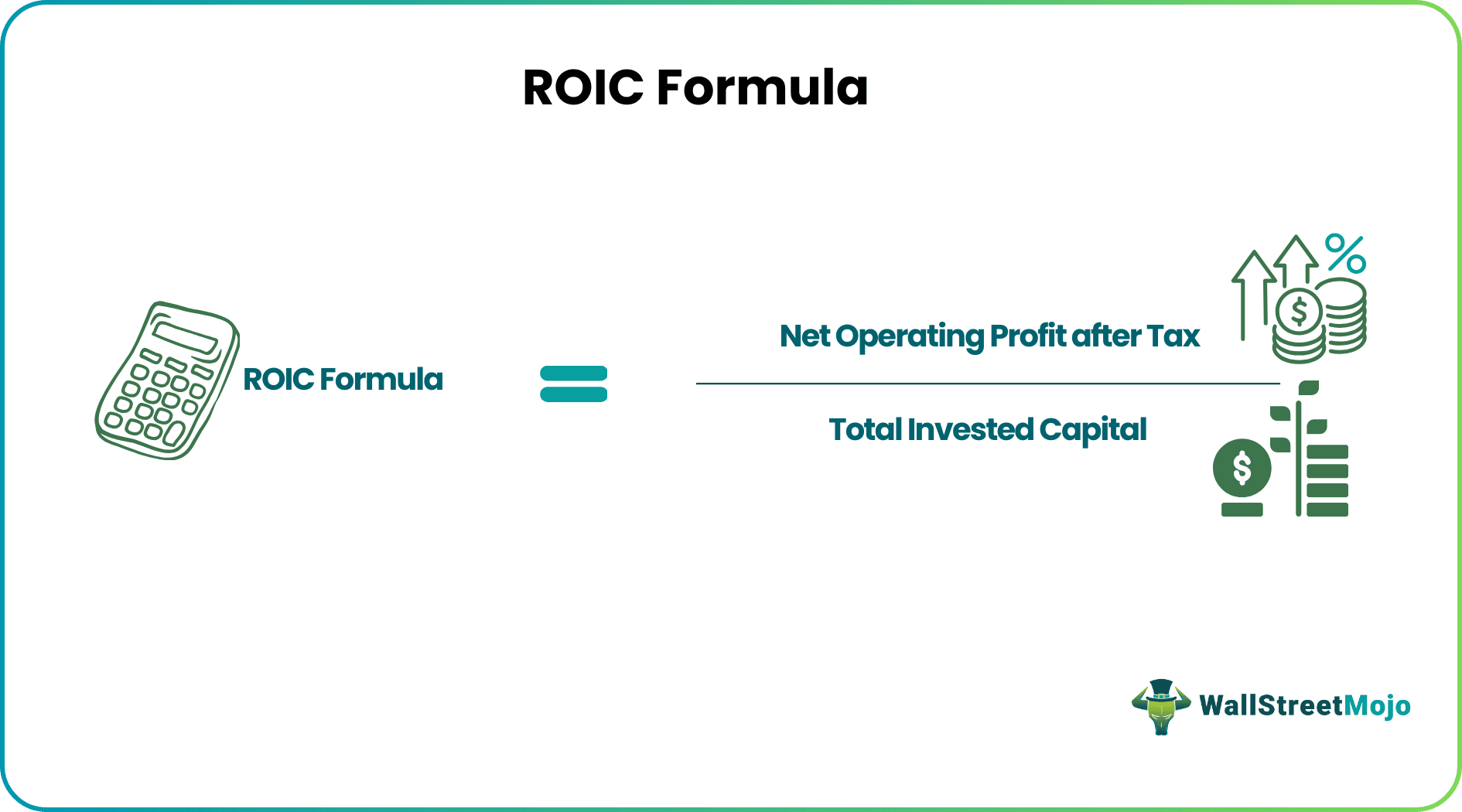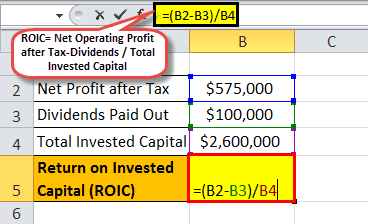Table Of Contents
What Is ROIC Formula?
ROIC Formula (Return on Invested Capital) is considered profitability and a performance ratio. It is calculated based on the total cost and the return generated, and returns are the total net operating profit after tax. In contrast, investments are calculated by subtracting all the current liabilities from their assets.
The formula is represented as below,
ROIC Formula = Net Operating Profit after Tax / Total Invested Capital

Key Takeaways
- ROIC measures a business's profitability by comparing the total cost to net operating profit after taxes. Investments are calculated by subtracting current liabilities from assets.
- The ratio is used to measure a company's ability to generate returns from its capital.
- In addition, it helps investors understand the profitability of their investments by showing the percentage of money the company has converted into returns.
- Analyzing ROIC trends helps companies make informed investment decisions, debt management, and renewal options.
Explanation
The "Return" that the company has generated from all the capital it has used up during the period. ROIC calculation is done by using the Net Operating Profit. Once the Operating Profit is calculated, we deduct Tax from the same, as we need Net Profit.
The denominator is the total invested capital by the company during that particular period. It may include capital raised from the market plus the company’s equity.
In this ratio, we are trying to determine the percentage of conversion of capital into returns by the company. Hence, this is used as a profitability ratio.
Video Explanation of ROIC Formula
Example of ROIC Formula (with Excel Template)
Let’s see some simple to an advanced example to understand it better.
Example #1
Company ABC manufactures Copper wires. In the year 2016, its net profits were $500,000. The company management decided to enhance sales and thus profits as an objective for 2017. For doing this, they raised capital in stocks amounting to $2.5M. The retained earnings to be used for 2017 were $100,000. At the end of 2017, they made a Net profit (after tax deductions) of $575,000 and paid $100,000 as dividends to stockholders. We need to do the calculation of ROIC for 2017.
- Net Profit after Tax: $575,000
- Dividends paid out: $100,000
- Total Invested Capital: $2,500,000 + $100,000 = $2,600,000
In the below-given template is the data of Company ABC for the ROIC calculation.

So, the Calculation of ROIC of Company ABC will be as follows:
Return on Invested Capital Formula = Net Operating Profit after Tax -Dividends / Total Invested Capital
ROIC =($575,000 - $100,000)

So, Return on Invested Capital will be:

Return on Invested Capital of Company ABC =18.3%
Analysis: The company has a good return capacity. It means that if we invest 2.5M in the company, it generates $575K of profit after all tax deductions, with a capacity to repay $100,000 to its stockholders.
Example #2
Triumph Solutions made a net profit of $500,000 in 2015. The total invested capital is $1,800,000 for the year. The legal tax rate is 40%. Calculate the ROIC for Triumph Solutions for 2015.
In the below-given table is the data of Triumph Solutions for the calculation of ROIC.

Therefore, the Calculation of ROIC of Best Paints Ltd will be as follows,
ROIC = $100,000 /$2,000,000

So, Return on Invested Capital of Best Paints Ltd will be:

ROIC of Best Paints Ltd = 5.0%
Analysis: ROIC for the firm is only 5%. However, it should be noted that the total invested capital of $2M for the year, the major component is equity ($1.2M), with a debt of only $0.8M. Hence, the company would have to repay more to the investors than the debt holders.
Example #3
Triumph Solutions makes a net profit of $500,000 in 2015. The total invested capital is $1,800,000 for the year. The legal tax rate is 40%. Calculate the ROIC for Triumph Solutions for 2015.
In the below-given table is the data of Triumph Solutions for calculation of ROIC.
- Net Profit (before taxes): $500,000
- Total invested capital: $1,800,000
- Tax Rate: 40%

Therefore, Calculation of ROIC of Triumph Solutions will be as follows,
ROIC=$500,000 (1-0.4) / $1,800,000

So, Return on Invested Capital of Triumph Solutions will be:

ROIC of Triumph Solutions =16.67%
Relevance and Uses
ROIC is majorly used while analysts are working on company analysis. Majorly it is relevant for the following uses:
- ROIC Formula measures how well a company can convert its capital into returns. Hence, this ratio helps investors understand returns from their investments.
- With results calculated over a while for a particular company, one can follow the company's growth pattern and use this trend for forecasting the company's typical plans in the future.
- ROIC sometimes also suggests the capital structure of the company. With the breakup of the total invested capital to equity and debt, one can try to analyze the debt and equity ratio invested by the firm and, after that, understand its related future prospects.
- Analyzing ROIC over time can enable the company to understand its growth trend and make suitable decisions for future investments, renewals, and liquidation of existing debt components.
Conclusion
ROIC is a measure of the income generated by a company from its investments. The better the ratio, the better and more profitable it is to invest in the company. However, it is essential to understand that the denominator used is “total invested capital,” not debt or equity. Hence, analyzing the structure of its components would give a much better understanding to investors and analysts. A higher debt component may also mean that the company is using up its debt to generate returns – it may require to repay a higher component of returns to its loans.
Thus, a complete and true understanding of the company’s returns would only be made after each component of the numerator and denominator are properly analyzed.

